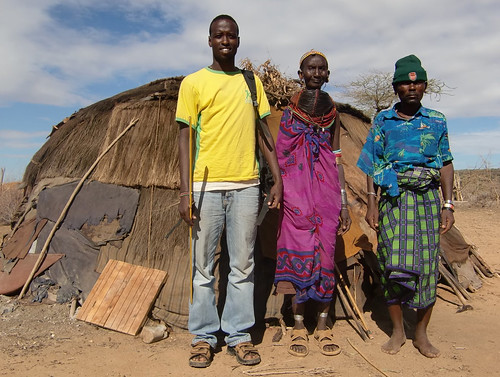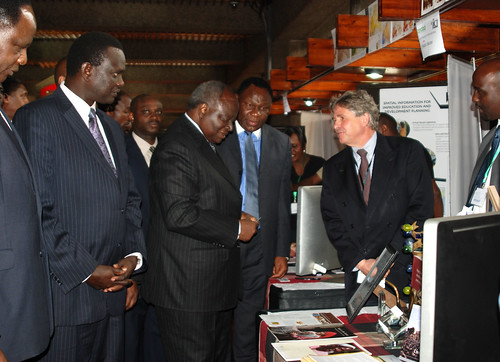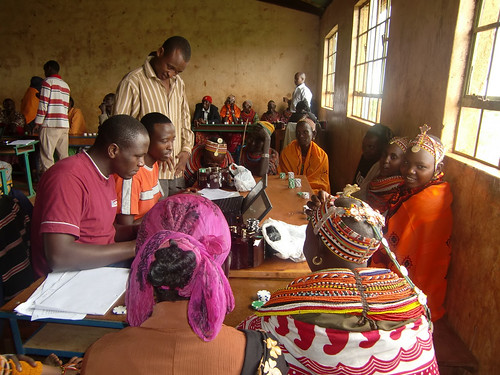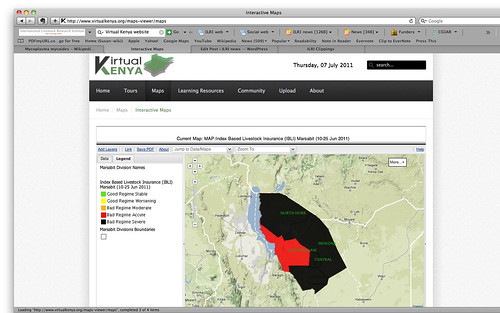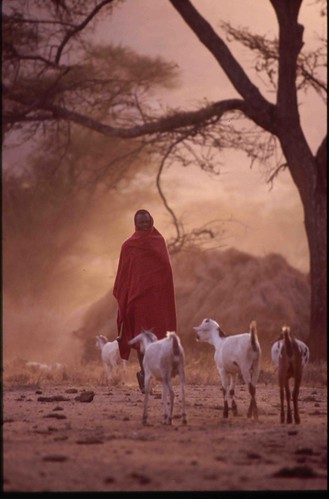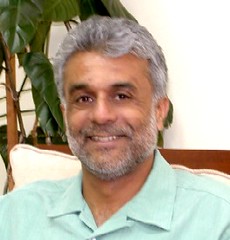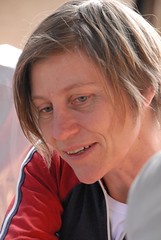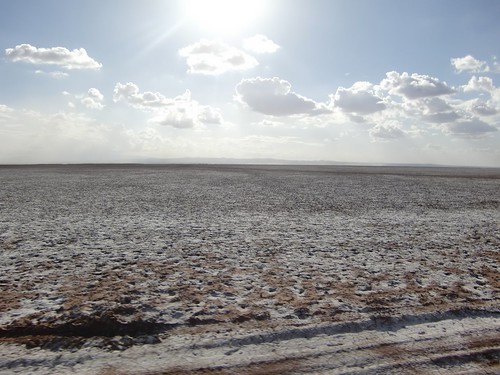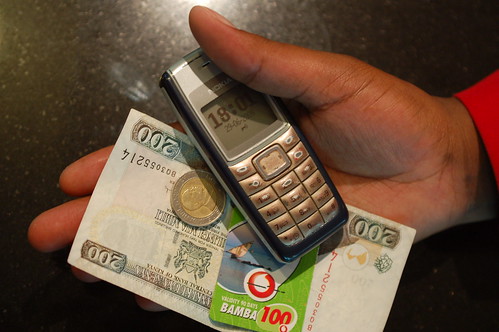
Mobile phone with money in Kenya (photo on Flicker by whiteafrican).
Kenya, which in recent years has built a reputation as an innovation hub—a nerve centre for young mobile and web developers—is making use of its new media technologies and platforms for dealing with an age-old problem of biblical proportions and resonance: a current drought and starvation now ravaging the Horn of Africa, including Kenya’s northern frontier districts of Turkana, Marsabit, Wajir and Mandera.
With its vibrant cell phone infrastructure and use, Kenya is home to illustrious tech start ups such as Ushahidi, a ‘disruptive’ non-profit tech company (‘ushahidi’ means ‘testimony’ in Swahili) offering open-source software and crowd-sourcing tools to better inform responses to crises; the iHub, a new nerve centre for mobile and web developers; M-PESA, a mobile money transfer system readily available to the poor and initiated by Kenya’s big mobile company Safaricom; Virtual City, which is producing software for small business in this poor country; and iCow, a mobile application that allows farmers to monitor the fertility cycles of their animals and pinpoint breeding windows.
Kenya’s new generation of tech luminaries includes Erik Herman, creator of Ushahidi who was raised and is now living in Kenya and writes the popular White African blog; Ory Okolloh, Kenyan lawyer activist and Ted talker and Ushahidi co-founder and new Google Africa policy and government relations manager; John Waibochi of Virtual City, a Kenyan mobile mega-entrepreneur whose company is pioneering mobile business management solutions for small traders and won the 2010 Nokia Innovation Challenge Award; Su Kahumbu Stephanou, of Green Dreams Ltd., who won first prize in an Apps4Africa Competition in 2010 and invented iCow; and Andrew Mude, a Kenyan from the country’s pastoral Marsabit District who is leading research on the first livestock insurance product made readily available to, and affordable by, Kenya’s remote livestock herders and who this year won Kenya’s inaugural Vision 2030 ICT Innovation Award.
But can Kenyans really use their new m- and e-philanthropy platforms to help rescue starving desert nomads in the northern frontier? Watch this space.
Below is some of the news coming out this week on how regular, tech-savvy, Kenyans are making use of the new mobile and web technologies to help their countrymen and women in Kenya’s remote northern drylands feed themselves in a great multi-year drought that has desiccated the pastoral lands, withering crops, finishing forage and killing camels, donkeys, goats, sheep and cattle alike.
Safaricom Foundation press release, 27 Jul 2011
‘The Safaricom Foundation and KCB [Kenya Commercial Bank] Foundation today led a coalition of corporate Kenya and media in launching a massive fund-raising effort aimed at reversing the suffering of an estimated 3.5 million Kenyans faced with starvation. Dubbed KENYANS for KENYA and intended to raise over Sh500 million, in four weeks. The initiative has brought together a number of organizations among them Safaricom Foundation, KCB Foundation and the country’s leading media houses operating under the umbrella of the Media Owners Association (MOA). The effort will be administered by relief agency Kenya Red Cross Society. . . . KENYANS for KENYA, touted as the biggest such effort ever mounted in Kenya, shall be co-ordinated on several fronts, including pledges from corporate society that will be made public during a meeting set for next Friday, August 5 at Serena Hotel. Also key to the campaign is the use of M-PESA, Safaricom’s money transfer service to receive donations. This will ensure that even the smallest donation (as low as Sh10) is harnessed, as this will go a long way in improving the situation of millions of Kenyans currently staring starvation and death in the eye. Donations can be sent to the M-PESA PayBill number 111111 at no charge as this has been waived. Donations can also be sent to account number 11 33 33 33 38 at KCB.
Capital FM News, 28 Jul 2011
‘The Kenyan media has already joined hands with the corporate sector to raise Sh500 million in the next four weeks for drought stricken Kenyans. The initiative dubbed Kenyans4Kenya which was launched on Wednesday has brought together Media Owners Association, Safaricom and KCB foundations among other organisations. Kenya Red Cross Society will manage the fund that will be used to purchase food relief to the drought stricken Kenyans. Donations can be sent through the M-PESA Pay Bill number 111 111 at no charge or account number 11 33 33 33 38 at KCB.’
Mashable, 30 Jul 2011
‘Like most major international crises today, Twitter is the go-to forum for Africans to discuss the situation on the ground. Users are asking for the international community to send aid to the starving region of the world’s poorest continent. The International Business Times reported twenty tweets per minute relate to the famine in East Africa, using the hashtags #HornOfAfrica, #Famine, #Drought, #Somalia, #Kenya and #Ethiopia. Groups such as Kenyans4Kenya, a campaign of Kenyans helping other Kenyans, have started to respond to calls.’
‘Kenyans4Kenya’ initiative on Facebook, noon 30 Jul 2011
As at 10:00am ksh we are at 47,502,973 can we hit the 50M mark before noon? yes we can. let’s do it.
about an hour ago via Facebook Mobile
Gladys Kamau Nimehesabika! BN78KK393! GO KENYANS!
I knew we could do without the politiians….infact they are an expense to us!
Polly Mbugua Now they must be scared – all attention has shifted to this noble act…..Can we continue giving them a black out? Media houses you can be again of great help.’
Kenya Red Cross Society on Facebook: 29 Jul 2011
‘HI GOOD PEOPLE, THANK YOU FOR CONTRIBUTING TOWARDS KENYANS FOR KENYA & FEEDKENYA INITIATIVES. . . . THERE ARE ONLY TWO INITIATIVES THAT KRCS IS RUNNING- THE MPESA NO FOR K4K IS 111111 AND FEEDKE IS 10000. THE KCB ACCOUNT IS 1133333338 ANY BRANCH. BY KRCS PR AND COMMUNICATIONS MANAGER, NELLY MULUKA. LET US CONTINUE ALLEVIATE HUMAN SUFFERING.’
Blog by Ahmed Salim: #FEEDKE social media campaign, 10 DAYS and Counting, 29 Jul 2011
After 10 days of full dedication to an initiative I started off with just one tweet has taught me a lot. . . . A campaign that is ongoing for more than a week with no offline help makes me proud to say Social Media is our future. . . . Do you realize for the 1st time Kenyans Online all over the world are doing something as ONE with ONE common goal?? The support im getting online on all social platforms just boosts my energy to ask for one more tweet – and you know what? WE WILL MAKE IT HAPPEN. I am NOT stopping as yet – together we will Feed Kenya. . . . Till date of this post we have raised Kshs.624,602.20/= from 1130 donors via Online, Mpesa and Airtel. We are all Kenyans and let’s keep everything else behind us today and stand proud to do something for this country – lets Unite and speak one language. . . . Kenyans WE can DO this together – We can show our strength as ONE – We can make a difference just as an individual. Your say counts, your participation counts, your heart counts and more your ACTION counts.
Sacrifice A Meal Today; Take pride, stand for Kenya and support FeedKE:
M-Pesa Paybill to ‘10,000’ Acc ‘feedke’
On Airtel nickname ‘REDCROSS’ reference ‘feedke’
Online: www.kenyaredcross.org
Ps: all funds are collected directly by the Kenya Red Cross Society and a report is available on request. . . .
My name is Ahmed Salim and I’m a Kenyan!!
May God Bless YOU and GOD BLESS KENYA!!!!
Magu Ngumo in an opinion piece in Kenya’s Saturday Nation newspaper, 30 Jul 2011
‘. . . Politics has overtaken agriculture as the mainstay of our national life. Even MPs from the famine-stricken parts of Kenya are not coming out boldly to rally support from the entire nation for their dying kith and kin. As recently observed by the world respected Special Adviser to the United Nations, Prof Jeffrey Sachs, Kenya has all the time ignored the early warning signs for its recurrent drought and resultant famine. How can the nation abdicate its cardinal responsibility of feeding its people and wait for the rest of the world to feed it? . . . The time for saving Kenyans who are dying of hunger is now. The war to save Kenyans from hunger should not just be left to the Government. It is every Kenyan’s war. . . .’
<><><>
If you’d like to donate to the famine victims through international organizations, here are eight of the bigger humanitarian agencies collecting money online:
CARE
Concern
International Rescue Committee
Oxfam
Save the Children
UNICEF
World Food Programme
World Vision
<><><>
A video production of Kenyan musician Eric Wainaina and children singing his popular Kenyan song Daima, is making new rounds in the social media. ‘Eric chose to work with Shangilia kids to make this video soon after Kenya’s post-election violence of 2007. The voices of the kids are mixed in with Eric’s original track. This patriotic song was used extensively to bring back sanity to a beautiful land that was rapidly consuming itself after the 2007 elections. The video is on Eric’s music video DVD called ‘Daima: The Music Videos’ that has been on sale for some time now.’ The Swahili lyrics and English translation of the chorus of Daima follow.
Lyrics of the chorus of Eric Wainian’s ‘Daima’ (‘Always’)
Naishi, Natumaini,
Najitolea daima Kenya,
Hakika ya bendera
Ni uthabiti wangu
Nyeusi ya wananchi na nyekundu ni ya damu
Kijani ni ya ardhi, nyeupe ya amani
Daima mimi mkenya
Mwananchi mzalendo
English translation
I live, I hope, I give myself for Kenya.
The certainty of the flag is my steadfast support.
The black is the people, the red is the blood,
The green is the soil,
The white is peace.
Forever I am a Kenyan,
A patriotic citizen.

